Gurudongmar Lake
Gurudongmar Lake is one of the highest lakes in the world and in India, located at an altitude of 5,430 m (17,800 ft),[1][2] in the Indian state of Sikkim.[1] It is considered sacred by Buddhists, Sikhs and Hindus.[2] The lake is named after Guru Padmasambhava—also known as Guru Rinpoche—founder of Tibetan Buddhism, who visited in the 8th century.[1][3]
| Gurudongmar Lake | |
|---|---|
Buddhist Holy Lake -Gurudongmar Lake | |
| Location | North Sikkim, India |
| Coordinates | 28.02°N 88.71°E |
| Basin countries | Sikkim, India |
| Surface area | 118 hectares (290 acres) |
| Shore length1 | 5.34 kilometres (3.32 mi) |
| Surface elevation | 16,909 ft (5,154 m) |
| Settlements | Mangan, North Sikkim 122 km. Lachen, North Sikkim 67 km. |
| 1 Shore length is not a well-defined measure. | |
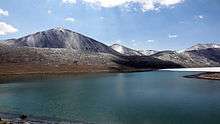
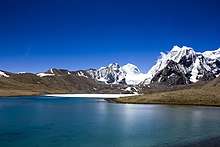
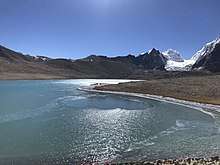
Geography
The high altitude lake is located 190 kilometres (120 mi) away from Gangtok, the capital city of Sikkim, and about 5 kilometres (3.1 mi) south of the Tibetan (Chinese) border, in the district of North Sikkim. The lake can be reached by road from Lachen via Thangu. The road from Thangu to Gurudongmar passes through rugged terrain with moraine, which has high alpine pastures covered with many rhododendron trees.[4][2] While Indian tourists are allowed to visit the lake, foreigners need to get a special permit from the Ministry of Home Affairs in Delhi.[5]
Features
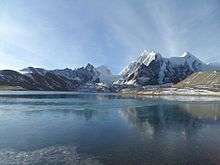
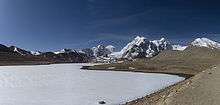
The lake, fed by glaciers, is located to the north of the Kangchengyao range, in a high plateau area connected with the Tibetan Plateau. It provides one of the source streams which joins the Tso Lahmu and then form the source of the Teesta River. The lake remains completely frozen in the winter months, from November to Mid-May.[4][6]
The lake has an area of 118 hectares (290 acres) and its peripheral length is 5.34 kilometres (3.32 mi).[4] However, the size of the lake appears small at the place where the devotees offer worship because the larger part of the lake is not visible due to hilly topography obstructing the view.[1] The area surrounding the lake, also known as Gurudongmar, is inhabited by Yaks, blue sheep and other wildlife of high altitude.[4]
The lake is fresh water and used to be very clear; the bed of the lake could even be seen from the middle of the lake. Pollution has muddied the waters in recent years, and the lake has taken on a white tinge and has obscured visibility.[1]
In Folklore
A legend related to the frozen condition of the lake is linked to the visit of Guru Padmasambhava to the lake, on his way back from Tibet. When he saw it, he felt that it was worthy of veneration, as it represented the divine location of Dorje Nyima or Chhoedten Nyima. Because the lake remained frozen most of the year with no possibility of providing for drinking water needs, the people of the area appealed to Padmasambhva to help them. The guru agreed to help and placed his hands on a small part of the lake area, which stopped freezing during winter, facilitating drinking water to the people. Since then, the lake has been considered sacred and devotees carry this sacred water in containers.[2]
According to another legend, when Padmasambhava visited the lake he saw an auspicious phenomenon and then he considered it a good augury to enter the mainland of Sikkim, then known as Demojong.[1]
Some stories say that in the 15th century, Sikh Guru Nanak Dev Ji passed through the lake while on his return from Tibet, he was asked by the local people of Gurudongmar Village to help make the frozen lake a source of drinking water during the winter period, he touched part of the lake with his walking stick, making the lake free of snow throughout the year. The stories also say that he blessed the lake, announcing to the villagers that "whoever takes the water of this lake will gain virility and strength". According to this story, disputed by the Namgyal Institute of Tibetology, the lake and the surrounding hills derive their name from Guru Nanak's visit.[7][8]
Dispute
A dispute arose when on the bank of the lake an Indian Army regiment of Sikhs—located at the border with China—considering the lake as the place visited by their saint Guru Nanak, constructed a Gurudwara in 1997–1998. This created anger among the Sikkimese people of the area, who considered the Gurudwara an illegal construction, because their ancient sacred lake had been sanctified by the visit of their Guru Padmasambhava. The government of Sikkim then constituted a high level committee to examine the issue and submit a report. Documents furnished to the committee by the Namgyal Institute of Tibetology, Gangtok, agreed with the claim of the local people that it was without a doubt a Buddhist religious place. This was accepted by the committee. The building constructed by the Sikh regiment was then handed over by the Army to the Lachen Monastery on 6 July 2001, in the presence of the Sub Divisional Magistrate, Chungthang, North Sikkim. The monastery placed a lama as a watchman at the lake, entrusted with the task of maintaining it.[1][9]
See also
| Wikimedia Commons has media related to Gurudongmar Lake. |
- Tourism in North East India
- Tilicho lake
- Lake Tsongmo
- Khecheopalri Lake
References
- "North Sikkim - Tourist Places - Gurudongmar Lake". District North Sikkim, Government of Sikkim | District Administrative Centre, Mangan, North Sikkim | India. District North Sikkim, Government of Sikkim | District Administrative Centre, Mangan, North Sikkim | India.
- "Gurudongmar Lake". Official website of Sikkim Tourism, Government of Sikkim.
- Dalvindar Singh Grewal (January 1995). Guru Nanak's travel to Himalayan and East Asian Region: a new light. National Book Shop. pp. 67–68. ISBN 978-81-7116-177-5.
- Panigrahy, S; Patel, J G; Parihar, J S (September 2012). "National Wetland Atlas: High Altitude Lakes Of India" (PDF). Gurudongmar Lake. Space Applications Centre, ISRO, Government of India. p. 83.
- Vanessa Betts; Victoria McCulloch (10 February 2014). Indian Himalaya Footprint Handbook: Includes Corbett National Park, Darjeeling, Leh, Sikkim. Footprint Travel Guides. p. 352. ISBN 978-1-907263-88-0.
- Husain. Understanding Geographical Map Entries. Tata McGraw-Hill Education. pp. 282–. ISBN 978-1-259-00090-4.
- Dalvindar Singh Grewal (January 1995). Guru Nanak's travel to Himalayan and East Asian Region: a new light. National Book Shop. pp. 67–68. ISBN 978-81-7116-177-5.
- The Sikh Review. Sikh Cultural Centre. 2001.
- Mohinder Singh (1 January 2001). Punjab 2000: Political and Socio-economic Developments. Anamika Publishers & Distributors. pp. 25–. ISBN 978-81-86565-90-2.
External links
| Wikimedia Commons has media related to Gurudongmar Lake. |
Gurudongmar Lake- Permit Regulations Climate Temperature Height